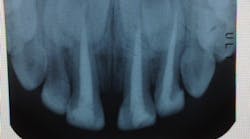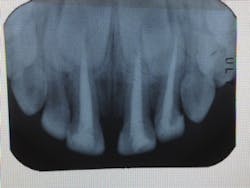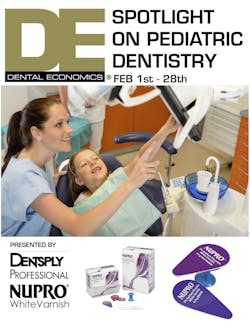Editor's note: For part I of this article, click here.
For those of us who treat baby bottle syndrome / early childhood caries (BBS/ECC), saving or restoring the beautiful smile of a toddler or pre-schooler (we’ve treated children as young as 14 months) can be quite challenging. Often, the primary anterior teeth are decayed to the point that there is little tooth structure left and the decay is deep, exposing the pulp or leaving it severely compromised.
Full pulpectomy (what the CDT code calls “Pulp Therapy”) is often indicated as indirect pulp caps (IPC) or pulpotomies may lead to abscesses and loss of the tooth.
Here’s a relatively quick, easy pulpectomy technique that will help save the tooth and, just as importantly, not interfere with the development and eruption of the succedaneous permanent tooth:
With anterior primary teeth, if the decay is deeper than “superficial,” pulpectomy may be indicated. In my experience, IPC’s and pulpotomies in those teeth often lead to abscesses and more failures.
To remove the vital, but hyperemic pulp, place 3 fine/x-fine broaches down the canal and slowly “twirl” them around each other. By doing that, the pulp will be intertwined onto the broaches and can be removed, often in one piece. Gentle filing with a #40 Hedstrom or Fine-Cut file (NEVER longer than 16mm) will remove remaining pulp remnants. It is NOT necessary, nor advisable to irrigate with bleach. I use local anesthetic solution to irrigate, then dry with paper points, disinfect and control hemostasis with your medicament of choice on a paper point, and fill with a resorbable, NON-HARDENING paste. I use Vita-Pex, an iodoform / calcium hydroxide formulation that does not harden, and will resorb with the tooth. Pastes that harden, like ZOE, often will not resorb as quickly as the tooth, and can deflect the path of eruption of the permanent tooth.
After filling the root canal, carefully remove the Vita-Pex from the pulp chamber with a caries excavator, down to the level of the gingiva, so as not to stain the crown of the tooth (Vita-Pex has a yellowish color and will “shine through”), and also to leave room for a Resin Modified Glass Ionomer (RMGI) to be placed in the tooth chamber to seal the canal. The RMGI can even be extruded past the chamber to act as a core for the composite crown that will be built on the tooth, as described in “Strip Crown Success.”
There are very few things in life more rewarding than restoring the smile of a beautiful child!
--------------------------------
Dr. Howard Elson is a pediatric dentist practicing in McKeesport, PA. For full bio, see below.
--------------------------------
This article is a part of the Dental Economics "Spotlight on Pediatric Dentistry," with exclusive content posted on the Dental Economics Facebook Page and archived at http://www.dentaleconomics.com/pediatric-dentistry-spotlight.html. The spotlight runs February 1st - 28th, 2014, in recognition of National Children's Dental Health Month, and is sponsored by Dentsply Professional and Nupro White Varnish.
--------------------------------
Dr. Howard Elson is a graduate of Queens College in New York City and the New Jersey Dental School (which became the University of Medicine and Dentistry of New Jersey, which became Rutgers). After serving in the U.S. Army at Fort Jackson, SC, where he “preserved the biting strength of our combat troops,” Dr. Elson completed his residency at Allegheny General Hospital in Pittsburgh. After he graduated, they closed the program and bought helicopters with the money they saved.
Dr. Elson has presented many seminars and lectures on pediatric dentistry, and has served as local dental society president and public relations director for the Dental Society of Western Pennsylvania. He has served as Associate Clinical Professor at the University of Pittsburgh School of Dental Medicine and started the pediatric dental program at Southwestern Ambulatory Surgical Center, where he maintains a staff appointment. A Fellow of the International College of Dentists, Howard has received awards and commendations from the United States Army, Alpha Omega Dental Fraternity and the American Society of Dentistry for Children, among others. He is currently a consultant with Avesis Dental and a member of the ADA Medicaid Provider Advisory Committee. At the 2013 ADA Convention in New Orleans he presented, “Why I Am a Medicaid Provider.”
Howard is also a professional actor and singer, having starred in productions of “Fiddler On The Roof,” “Chicago,” “A Little Night Music,” and “A Funny Thing Happened On The Way To The Forum,” among others. He has had his own sports talk show and in 1988 was honored as “Western Pennsylvania’s funniest and best commentator” for his sports/humor radio commentaries. He also travels the country performing his one man show for dental conventions, “Dr. Howard Elson, A Dentist’s Life!” His CD of special material songs and comedy, all about the practice of dentistry, can be purchased on his website, www.thedentalshow.com.
Howard and wife Robin, a CPA, have two children; Philip, the play by play voice of the Arkansas Travelers, the AA affiliate of the Los Angeles Angels of Anaheim, married to Julie, and Lauren, the Family Life Director at the Jewish Community Center of Pittsburgh, and four beautiful (are there any other kind?) grandchildren; Sadie, Gabriel, Dylan and Lily.
--------------------------------








